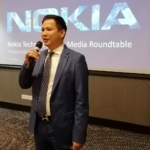EITN: Can you share how Covid’s impact has reoriented the various blockchain projects under Oracle, or various blockchain projects that Oracle observes in its ecosystem?
Fitri: Certainly we are seeing more blockchain projects coming through. This is backed up by what analysts are saying. In fact, according to Gartner, 2021 is the year enterprise (permissioned) blockchain begins its long climb out of the ‘trough of disillusionment’, with its annual survey of blockchain service providers showing an increase in enterprise blockchain projects in 2020; this is up about 10 percentage points from the previous year. There is also the expectation that production use cases will continue to keep growing by double digit percentages in 2021, albeit from a small base.
But what is clear is that the pandemic has seen many companies re-focus their IT spend and initiatives on generating near-term savings, risk reduction, and business optimizations. For blockchain this has led to an increased emphasis on projects which can reduce time and costs, and speed time to impact.

An example is our work with HACERA which is enabling access to reliable, real-time date to curb virus spread.
The rapid spread of COVID-19 left researchers and healthcare professionals searching for real-time data about the spread of the virus – and who it impacts – to help slow its spread while vaccines roll out. To help meet the need for reliable information about the virus, HACERA and Oracle worked together with other technology and healthcare organizations to deliver reliable information via the MiPasa platform.
An example is our work with HACERA which is enabling access to reliable, real-time date to curb virus spread.
MiPasa is a blockchain-based, distributed data platform launched by HACERA. It simplifies and streamlines the process of sharing and using data from multiple providers, making it accessible to researchers, software developers, and decision-makers worldwide. Given the size of the data sets – relating to the number of cases found, health outcomes, or vaccine trials – Oracle Blockchain Platform helps bring the scale needed.
EITN: How do you see this impacting Gartner’s prediction that 2021 is the year of the enterprise blockchain?
Fitri: It’s not just Gartner that is predicting blockchain growth; Deloitte’s Global Blockchain Survey found that blockchain’s standing as a top-five strategic priority continued in 2020 with some 86% of respondents saying that blockchain offers a compelling business case.
But blockchain projects do have a notoriously high failure rate. IDC caputures some of the problems when it calls out the technical complexities and costs connected to the creation and configuration of a blockchain and to maintain the infrastructure are often seen as a barrier.
So to realize the promise of blockchain, what we really need is something that makes it easy to implement. And that’s what we’ve really focused on – taking blockchain technology and making it super easy to implement, particularly for enterprises and governments.
EITN: Blockchain works to ensure enterprise data flows across ecosystems like supply chains while maintaining their integrity and trustworthiness. Can you share any observations you have around supply chains upheavals as result of borders being more restrictive, and countries realising they need less reliance on certain countries, etc.
Fitri: As you say, up to now, blockchain has primarily been used for decentralized multi-party applications such as supply chains. And certainly, there were multiple supply chain disruptions as a result of border lockdowns, especially early on.
While blockchain may not be able to address the impact of COVID-19 directly, it does help with supply chain visibility.
Take the example of Tesla’s pilot with COSCO SHIPPING LINES and the Shanghai International Port Group. Its aim was to expedite the cargo release process and it highlights the speed and process optimization benefits that can be gained when an ocean carrier can share trusted shipment data with the terminal operator and easily verify the consignee and the shipping agent. This example uses applications developed by Oracle blockchain customer, CargoSmart, as part of the Global Shipping Business Network (GSBN) blockchain consortium.
While blockchain may not be able to address the impact of COVID-19 directly, it does help with supply chain visibility.
Getting access to this visibility throughout the supply chain journey is key to optimising efficiency and agility even during normal production. In times of supply chain disruption, it becomes even more crucial as it helps companies in the ecosystem can plan and take action, such as developing routes to alternative suppliers.
EITN: Please share the top capabilities of blockchain, and also Oracle Database 21c now that blockchain is integrated (?) with it.
Fitri: Blockchain, as mentioned offers many benefits. Among those are its ability to help improve visibility through real-time data sharing, verification of transactions which helps increase trust, reduction in risk and fraud, and lowering costs transaction and faster processing times.
Oracle has a range of enterprise class blockchain solutions that help companies harnesss and benefit from this technology quickly and easily.
We have Oracle Blockchain Platform, available both as a cloud offering and on-premises that enables users to easily create a permissioned, multiparty blockchain network for secure collaboration in minutes and also quickly integrate it with back-office applications.
What we’re talking about here is adding blockchain technology into the Oracle database to provide crypto secure data management.
So to give context – if we look at existing enterprise security technologies, they’re largely focused on keeping criminals out through things like passwords, privileges, encryption, firewalls, that kind of stuff. With this addition we are bringing an additional layer of security. It is not replacing what we already have, rather it’s adding additional protection for data from being illicitly modified or deleted.
By adding this capability into the world’s leading, enterprise database, we’re enabling organisations get the full functionality of the database, and bring blockchain technology into the mainstream without needing any application changes.
The intention is to give them another means to help protect data of record, things like contracts, property, titles, payments, transfers, ledgers accounts, statements, and so it. This is important data that needs to be preserved and not modified in any way.
We are doing this by taking advantage of four critical components of blockchain technology: namely immutability, cryptographic digests, cryptographic signatures, and distributed systems. Each component is responsible for protecting against a different aspect of illicit data changes performed using legitimate user credentials or by hackers.
To help prevent illicit or even accidential changes by insiders, we have added immutable blockchain tables (insert-only tables) into Oracle Database 21c. This makes it possible to insert new data, but existing data cannot be changed or deleted by anyone using the database, not even database administrators.
To help detect illicit changes by hackers we’ve used cryptographic digests. Here, the blockchain detects changes to data by computing and safely storing a small cryptographic digest of the data added. So, if the data is changed, then the the cryptographic digest of the changed data will differ from the previous digest and will show up as it won’t match when it is compared.
To help detect illicit changes by hackers we’ve used cryptographic digests.
However, should there be an illicit change by someone from inside the company or a very sophisticated hacker, and where there is a large scale cover up, we also enable the distributed publication of a data digest. This uses the cryptographic technology to summarize the data and then enable that summary of the data to be shared and safely stored away. The idea is that if somebody changes the data, then the cryptographic digest of the data again won’t match, so you can always detect that someone changed the data.
Finally, to prevent data falsification by impersonators there is end user data signing. This is addressed in blockchain technology by allowing end users the option to cryptographically sign the data as they insert it.
This is all happening inside the Oracle Database. It’s also important to note that this is not a special purpose database, like Amazon has. It is a general purpose database in which this technology is delivered as a free feature, and is available in all of the current database editions within 19C as well as the new 21c. Additionally, users don’t have to change their applications at all to make this work and it uses the standard SQL language that DBAs are used to.
Finally, to prevent data falsification by impersonators there is end user data signing.
You can also run full analytics and transactional workloads against the blockchain protected database, and customers can also use all of our standard features like, scale up clusters, data guard, disaster recovery, against the blockchain tables.
EITN: What are the main business outcomes that enterprises will see, from easier implementation of blockchain?
Fitri: There are always hackers trying to hack data, risks of insiders changing information or stealing others’ credentials and so on. Having blockchain built into the database this will help prevent activities like these from happening.
- Blockchain is also able to bridge across many parties and their data, cutting through many of the interoperability and trust issues that slow down business processes. This helps compamnies boost collaboration and strengthen their relationships, share data, and execute transactions.
- Examples of some of the more common use cases across various industries include:
- In the financial services industry to help secure and verify assets and payments
- Logistic data
- Education – against data like degrees and certifications
- Government data – for titles, legal documents, citizenship documents.
- Corporate data – for any kind of important document inside a corporation, such as invoices, payments, contracts, employee records, intellectual property
- These are all very valid and necessary and by making it easier for blockchain to be adopted across these types of industries and applications, we’ll see it mobbing to being used by the masses.







